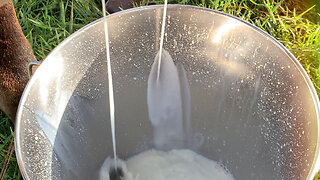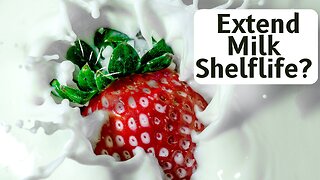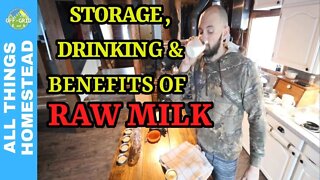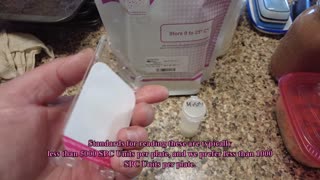How Long Should Raw Milk Last?
Have you asked yourself the question, “How long should raw milk last?” It’s a good question and I’ll address it today, and provide a great ice cream base recipe. You won’t have to worry about the cream lasting a long time. Your cream won’t last long because the ice cream recipe uses it up. Homemade ice cream is the perfect complement to an early autumn day that feels like summer is still hanging on.
Welcome new listeners and welcome back veteran homestead-loving regulars. I appreciate you stopping by the FarmCast every week. There wouldn’t be a show without you. Are you ready to get to it? Let’s go.
Today’s Show
• Homestead Life Updates
• How Long Should Raw Milk Last?
• Ice Cream Base Recipe
Homestead Life Updates
Garden
The garden is done. Well, there are a few sweet potatoes to be dug up, but other than that, it’s all gone. Whew. Now we can rest until the spring. Well, not quite. There are clean up tasks and winter preparation of the beds, adding compost to improve the soil over the winter and covering the beds to keep the moisture in and the weeds out.
Quail
We are ready for another batch of quail eggs in the incubator. Not so many as last time. Due to the reduction of daylight, they are laying much fewer eggs. Last time it was 47. This time less than 30. Whatever comes in today will be the last of this period of collection. Eggs can be collected for 7 to 10 days and kept in a cool environment but not in the refrigerator.
Most of our quail are brown coturnix. They are tan and brown with spotted plumage. We have one white one from the original batch of eggs that we purchased and one white one from that first batch that we hatched out about 2 months ago. They are already mature. The males are fertile and the females are old enough to begin laying eggs. We will take out enough females to fill out our breeding stock and the rest will go to freezer camp.
Cows
We are down to one bull from this year’s calves and we have just offered up Egwene for sale as well. She is our purebred Jersey heifer calf. Her mom is certified A2A2 and her sire is also certified A2A2. If you are interested please let us know. She is a lovely calf and quite affectionate if she thinks you have a bottle. We are weaning her and she has only a day or so left where she will get milk. At 5 ½ months old, she is developed enough to live on grass. Homesteading requires tough choices and letting go of favored animals is one of them. I will miss her but we have to be true to our plan.
Seasonal Affective Disorder (SAD)
The cooler weather we have had recently has been such a blessing. I hope it has been for you as well. I’m not a fan of summer. I like it okay in the beginning but it just seems to drag on and on. I’m the same way about winter. My favorite season is a toss up between spring and fall. Right now, fall is my favorite season, but I can guarantee you that in March my favorite season will be spring.
I tend to get seasonal affective disorder. Anyone familiar with that? As the winter drags on and there is less sun, vitamin D can be in short supply and depression may not be far behind. Usually by the end of January I’m feeling it and by the end of February I can be almost immobile. My level of motivation has fallen through the floor. These days I just accept what is and don’t try to fight it. I revel in my – shall I say – laziness and enjoy it while it lasts. Come spring the world will spin out of control with so much to do and no time to do it all. It’s a familiar cycle for me. I’ve learned to ride it like a roller coaster.
Let’s get to today’s topic.
How Long Does Raw Milk Last?
The short answer is nearly forever. The only thing that will stop you from consuming it is an aversion to the taste. First it becomes sour. Next it will thicken into yogurt. However, it will be a very strong yogurt. That yogurt will last a month or more. Along that time line you can drink the milk, use it in cooking, make cultured butter and buttermilk, and so on.
Contrast that with pasteurized milk. Pasteurized milk does not sour, it rots. It truly goes bad and is not safe for consumption. You do not want to put it in your mouth under any circumstances. On the other hand, when raw milk ages and starts to sour, this is good! Great, in fact.
What Makes Milk Sour and What Do I Do with It?
The reason raw milk starts to sour is because beneficial, probiotic bacteria amounts are increasing and using up the lactose sugar, making it taste sour, again, like a nice unsweetened yogurt. So, how long should your raw milk last when you get it home? Sandra Clark whose website is www.healthfoodnaturally.com, has this to say:
“If you get the milk the day it is milked, it will stay fresh up to 2 weeks. If it sours, no worries, it will become yogurt with no help at all (with a little sour cream on top).”
Without a starter, the sour cream on top usually bitters, so you can just scrape it off and compost it if you don’t like the taste.”
As for the yogurt, when we have left over milk at the end of the week, we just throw it in a ball jar and leave it in the fridge for if we get low on milk (because it has an amazingly long shelf life after turning into yogurt.)”
When we do run out of milk, we just throw some honey and fruit (usually berries) in and blend the yogurt into a tasty yogurt drink.”
I have some jars in there as old as two months and the yogurt tastes fine (well not like store-bought yogurt – to get that particular flavor you need to manipulate it with a bacteria starter like for cheese making – but with honey and fruit added it tastes wonderful!).”
So according to Sandra it should last up to 2 weeks in your fridge. In my experience, I have kept milk for nearly a month before it soured. Because in the spring we have tons of milk, this happens often. We just keep drinking it until the flavor goes off, then use it for other purposes.
What’s our Secret?
What is our secret to milk lasting so long? It’s two-fold. First, cooling it quickly. The faster it gets below 40 degrees, the longer it is going to last. The second key is keeping it very cold. The colder you keep the milk, the longer it will last. Our milk refrigerator is set to 34 degrees.
The problem that people have these days is having access to this great raw milk. I will do another podcast on how we got to this point. Today, I’ll just talk about where we are. There are lots of scary stories out there about how dangerous it is to drink raw milk. I say it’s hogwash and propaganda put out by some people in power with lobbyists to placate. The human species would have died out long before the pasteurization process was invented in the previous century if it was so dangerous. There are dangers in every food we consume. There are risks in every aspect of life. Assess your comfort level with the risk and make your choice.
Raw Milk Choice
The problem today is that in many states, there is no available choice for raw milk products unless you own your own cow. That’s why we started our herd share program. You can own part of a cow herd and receive the benefits of what your cows produce. More on that later. It’s so amazing to me that you can buy unpasteurized milk in the grocery store in 12 states, but the rest restrict it in various ways. It has to be labeled as pet milk in 4 states. 15 states allow it to be sold directly from the farm but not in the store. And of course, the herd share program is available in Virginia and 10 other states. In 9 states all sales are illegal and so are herd shares. So, 12 states think it is okay to for us buy raw milk and to consume it freely and the others are so certain we are all going to die of horrible illnesses that it has to be restricted or illegal altogether. I just cannot fathom the logic in this. If people were dying right and left, it would have been outlawed in all of those states wouldn’t it? Who is telling the truth?
Recent Studies Show Raw Milk Related Illnesses are Decreasing While Access is Increasing
You have to make up your own mind of course. And I will say again, there is risk in consuming any food. To help you with that decision as it pertains to raw milk, here is an article from the US National Library of Medicine Department of the National Institutes of Health (link in the show notes). It is titled Recent Trends in Unpasteurized Fluid Milk Outbreaks, Legalization, and Consumption in the United States.
There is a ton of really great information in this study. Lots of data, as you might expect, and lots of charts and graphs. It’s really good stuff. I’ll quote from the Abstract.
“Introduction: Determining the potential risk of foodborne illness has become critical for informing policy decisions, due to the increasing availability and popularity of unpasteurized (raw) milk.
Methods: Trends in foodborne illnesses reported to the Centers for Disease Control in the United States from 2005 to 2016 were analyzed, with comparison to state legal status and to consumption, as estimated by licensing records.
Results: The rate of unpasteurized milk-associated outbreaks has been declining since 2010, despite increasing legal distribution. Controlling for growth in population and consumption, the outbreak rate has effectively decreased by 74% since 2005.
Discussion: Studies of the role of on-farm food safety programs to promote the further reduction of unpasteurized milk outbreaks should be initiated, to investigate the efficacy of such risk management tools.”
So, there you have it. This study was initiated because they were pretty sure that the incidence of raw milk illnesses would increase as access was increased. They were wrong. There is now a push toward finding out if on-farm food safety programs are helping. I don’t need a study to tell me that they most certainly are. I’ve learned a lot of what I know because we have been studying cheesemaking for years. Others are just starting out and need to know about how to keep the environment sanitary and the milk clean. They need to know that it is really important to cool the milk quickly. Many still don’t use bulk milk tanks and have other ingenious methods of cooling the milk. A favored method is putting it in a freezer for 2 hours and then transferring to the refrigerator. I’m glad we have a bulk tank else frozen milk in broken jars would be a regular disaster. I get busy and forget stuff. Heck, I can walk into another room and forget why I went in there. Ever done that?
Raw Milk in Virginia
In Virginia, the way to have access to raw milk is via the herd share. You support the business by buying a share of the herd and get a designated rate of return on your investment. It is a commitment to be sure. It’s kind of like that wine buying club. You are committing to a certain amount of product per month for as long as you are a member.
If you’re looking for an affordable cow herd share program in southern Virginia or the Piedmont Triad area of North Carolina that has quality, healthy, and long-lasting raw milk, cheese, butter and yogurt, this is it. We are situated in Patrick County, Virginia just northeast of Mount Airy, NC.
Here are four reasons our cow herd share program is so good.
1. We offer 100% heritage breed Normande and Jersey milk, cheese, yogurt, cream and butter from cows with certified A2A2 genetics. I have a podcast on what A2A2 genetics means and I’ll include the link in the show notes. Briefly, there was as genetic mutation that happened a while back that changed the structure of the milk. Most milk today is NOT A2A2 in nature. One of the reasons we chose our heritage breed Normande cows was the purity of the ancient genetics.
2. We use antibiotics only at great need and absolutely NO growth hormones. Because we care for our pastures, our cows get only the best nutrition. Occasionally, there is a need for antibiotics. It’s no different than a human woman getting mastitis while breast feeding. Sometimes it happens and you take care of it. If it is necessary, that cow’s milk is harvested separately until the treatment and subsequent waiting period is long past. And the idea of forcing our cows to produce more milk with hormones is abhorrent to me. There is no regard for the health of the animal at all with hormones. There is only the focus on production. I don’t think those that use these artificial means of increasing milk even see that the cows are living beings. They treat them like machines. When they inevitably burn out due to over-taxing their bodies, they are shunted off to the sale barn and replaced with a younger model. It’s disgusting.
3. Our cows are out on grass all the time, and only come in for milking. They receive a small amount of non-soy, non-GMO grain supplement. This has two purposes. First, to entice the cow into the milking parlor and second to make sure she maintains her body condition. Our Normande cows can get by with absolutely no supplemental feed and maintain their body condition until late in the season. We choose to make sure they maintain body condition from beginning to end. The Jersey cow requires a great deal more supplemental nutrition. It is very easy for her to lose condition. I recently did a podcast on this as well (Normande vs Jersey – the Cost). The Jersey cow breed is a wonderful choice for many. But they do come with problems that we have not experienced with our Normandes. I won’t go into other details but, the days of Jersey cows on our homestead are numbered.
4. To join their herd share program, it only costs $60 AND one share is only $44 monthly! You can also purchase a half share for $30 and $22 per month or multiple shares if you have a larger family. The herd produces milk from the first week of May through the last week of October. Yogurt and sometimes cream is also available in that time frame. In the spring, there is always a glut of milk and we makes lots and lots of cheese with that. Our cheese are all raw milk cheeses. The legal requirement is that they be aged at least 60 days. However, none of our cheeses would be worth a darn at that young age. We age all of our cheeses well past that minimum. Some only come into their flavor after many, many months. And they get better and better with age.
Our Herd Share Program
Check out the Herd Share page on our website – www.peacefulheartfarm.com. Click or tap “herd share” on the menu to get more information. Or drop us a line via email or give us a call. We’d love to have a conversation with you.
Fun fact about raw milk. Remember the old wives’ tale about drinking warm milk to get to sleep? That is likely due to the tryptophan in the milk. However, it doesn’t really work anymore unless you have a raw milk resource. Pasteurization destroys the tryptophan. And that’s it for today’s topic. Let’s finish up with a late summer recipe for home made ice cream.
Ice Cream Base
When it’s warm outside, a cold refreshing dish of ice cream can really hit the spot. This is a basic ice cream recipe that can be used as a base for many different flavors. I’ve included a download link to the flavorings. This silky, luscious and very classic custard can be used as the base for any ice cream flavor you can dream up. These particular proportions of milk and cream to egg yolk will give you a thick but not sticky ice cream that feels decadent but not heavy. For something a little lighter, use more milk and less cream, as long as the dairy adds up to 3 cups. You can also cut down on egg yolks for a thinner base, but don’t go below three.
What You Need
• 2 cups heavy cream
• 1 cup whole milk
• ⅔ cup sugar
• ⅛ teaspoon fine sea salt
• 6 large egg yolks
• Your choice of flavoring
What To Do
1. In a small pot, simmer cream, milk, sugar and salt until sugar completely dissolves, about 5 minutes. Remove pot from heat. In a separate bowl, whisk yolks. Whisking constantly, slowly whisk about a third of the hot cream into the yolks, then whisk the yolk mixture back into the pot with the cream. Return pot to medium-low heat and gently cook until mixture is thick enough to coat the back of a spoon (about 170 degrees on an instant-read thermometer).
2. Strain through a fine-mesh sieve into a bowl. Cool mixture to room temperature. Cover and chill at least 4 hours or overnight.
3. Churn in an ice cream machine according to manufacturer’s instructions. Serve directly from the machine for soft serve, or store in freezer until needed.
Notes
Download the recipes for flavorings
Final Thoughts
I’m so glad that summer is winding down. It was a long, rough summer. And I missed about half of it because of the appendicitis. Again, not a huge fan of heat of summer. Remember to contact us if you are interested in a Normande bull to strengthen your herd genetics or if you are looking for that A2A2 Jersey heifer for yourself or to add to your herd.
If you’re not into raising your own cow but still want the benefits of raw milk products, we are here to help you out with that. For us the benefits of raw milk and raw milk products far outweigh the small risk factor. I’ll do another podcast on the statistics for the number and percentage of illnesses attributed to raw milk consumption shown in the larger scope of food in general. Where does raw milk fall in the list of food born illnesses from food in general?
I hope you try out some really great ice cream recipes in these last days of summer and the early autumn. Share your experiences in the comments on the recipe page. Link in the Show Notes.
If you enjoyed this podcast, please hop over to Apple Podcasts, SUBSCRIBE and give me a 5-star rating and review. Also, please share it with any friends or family who might be interested in this type of content.
As always, I’m here to help you “taste the traditional touch.”
Thank you so much for stopping by the homestead and until next time, may God fill your life with grace and peace.
References
• US National Library of Medicine, National Institutes of Health: Recent Trends in Unpasteurized Fluid Milk Outbreak, Legalization, and Consumption in the United States
• Peaceful Heart FarmCast: What is A2A2 Milk?
• Normande vs Jersey – the Cost
Recipe Link
Ice Cream Base with bonus flavoring recipes download
To share your thoughts:
• Leave a comment on our Facebook Page
• Share this show with your friends and family on Twitter, Facebook and Instagram
To help the show:
• PLEASE LEAVE A REVIEW for Peaceful Heart FarmCast on Apple Podcasts.
• Subscribe on iTunes, Stitcher Radio, Google Play Music, TuneIn or Spotify
• Donate on Patreon
Website
www.peacefulheartfarm.com
Patreon
www.patreon.com/peacefulheartfarm
Facebook
www.facebook.com/peacefulheartfarm
Instagram
www.instagram.com/peacefulheartfarm/
-
 11:50
11:50
LifeRegenerator
9 months ago $0.03 earnedI Love Drinking Raw Milk
170 -
 21:14
21:14
Digging Deeper Original Podcasts
5 months agoHealthy Living; Spoiled Milk
16.2K -
 1:15
1:15
This Humble Homestead
8 months ago $0.02 earnedThe Benefits of Drinking Raw Milk 🥛
8 -
 1:35
1:35
KeduQuickMinute
1 year agoMILK HACK - Add a little shelf-life to your milk?
27 -
 2:16
2:16
The Ball Is Wild
5 months agoRaw Truth : Unadulterated Milk
345 -
 0:15
0:15
2 Minutes to Life
7 months agoHow long is too long for a bulk
3 -
 14:21
14:21
back2basicscanning
2 years ago $0.03 earnedCanning Milk for Long Storage
1653 -
 18:50
18:50
Natren Precision Probiotics
5 months agoFermenting Danger: The Health Risks of Using Raw Milk
5 -
 9:00
9:00
Offgrid K and A
2 years ago $0.03 earnedStorage, Drinking and Benefits of Raw Milk
1232 -
 11:05
11:05
Farming, Homesteading & Family Thoughts
1 year agoIs Raw Farm Milk Safe on the Farm?
9